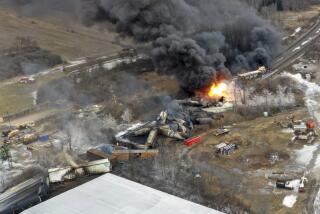Many Nations Seen Vulnerable to Poison Use
- Share via
WASHINGTON — The deadly Tokyo subway attack shows that officials around the globe are ill-prepared to protect the public from malicious uses of a huge range of lethal modern technologies--an especially frightening prospect in light of the apparent quantum tactical leap taken by whoever released nerve gas in Japan’s transit system, experts said Monday.
Although no individual or group has claimed responsibility in the Japanese incident, U.S. experts said it has sweeping implications for the United States and other open societies: Those responsible for the Tokyo attack have planted an idea and provided a map for others--including terrorists--to use poison gas against a civilian population.
And there now may be no way to put that ghastly genie back in the bottle.
“We’ve definitely crossed a threshold,” said Bruce Hoffman, former terrorist specialist at the RAND think tank in Santa Monica who now is at the Center for the Study of Terrorism and Political Violence at St. Andrews University in Scotland. “This is the cutting edge of high-tech terrorism for the year 2000 and beyond.
“It’s the nightmare scenario that people have quietly talked about for years coming true,” he said.
The Tokyo disaster suggests that an individual or a group managed not only to produce toxins but also to create systems to deliver them--a step that is actually the more difficult of the two, said Michael Moodie, president of the Chemical and Biological Arms Control Institute and former assistant director of the Arms Control and Disarmament Agency.
In a report little noticed until now, the institute investigated a similar attack in June in the central Japanese city of Matsumoto, which killed seven and sent more than 200 to hospitals after the nerve agent sarin penetrated several homes and apartments.
Weeks before the subway disaster, the institute concluded Matsumoto was a trial run to test a delivery system for the poison.
Based on preliminary evidence, U.S. officials believe that the gas used in the Tokyo attack was a homemade version of sarin or a weaker nerve agent. The industrial version of sarin would have resulted in far more deaths.
In the Matsumoto attack, other gases were mixed with sarin, Moodie said.
Sarin, experts said, can be made with common industrial chemicals used in the production, for example, of ink for ballpoint pens and of fertilizers. The knowledge needed to produce it is not deep; someone with a college science degree could do it.
Developing delivery systems is more difficult. Sarin, for example, is said to be highly corrosive. It would be dangerous for an extremist to handle and plant--a key reason why, tactically, it has not been used more often. At room temperature, sarin would be in liquid form. To disperse through the air, it must be a gas.
Officials in Tokyo are still investigating how it was spread through subways there. But the poison is believed to have leaked out of broken bottles and boxes wrapped in newspapers left inside five trains and at one station.
Because of the relative simplicity of their production, U.S. officials now fear that the use of chemical weapons may be copied by other extremist groups, organized crime or even oddballs seeking attention. This has been a common pattern after the introduction of other terrorist tactics--such as hostage seizures--over the last 25 years.
The potential impact could be acute because virtually no Western country has contingency plans to deal with chemical or biological terrorism. The United States, with its vast land and sea border, is likely to be even less able to prevent an attack than Japan.
“Contingency plans to deal with chemical or biological terrorism are woefully lacking,” said Vincent Cannistraro, a counterterrorism expert and former CIA official. “It’s difficult to provide physical security everywhere. And it wouldn’t be too difficult to introduce poison gas into a concentrated urban environment. The number of potential deaths is almost incalculable.”
Added Hoffman: “It’s too gruesome to think about. No one wanted to deal with it because no one knew what to do about it.”
Experts noted that virtually every major city in the world is vulnerable to attack by chemical weapons. As a rule of thumb, the more congested the city, the greater the dangers.
Los Angeles actually may have an advantage in dealing with such incidents, because the city is so spread out. “But if someone is determined and ruthless enough, it could happen virtually anywhere,” Cannistraro said.
If the United States came under chemical attack, the Federal Emergency Management Agency would take the lead, as it has in other national disasters. Other agencies would be marshaled, including the Centers for Disease Control and Prevention, the Pentagon and others.
More to Read
Sign up for Essential California
The most important California stories and recommendations in your inbox every morning.
You may occasionally receive promotional content from the Los Angeles Times.













